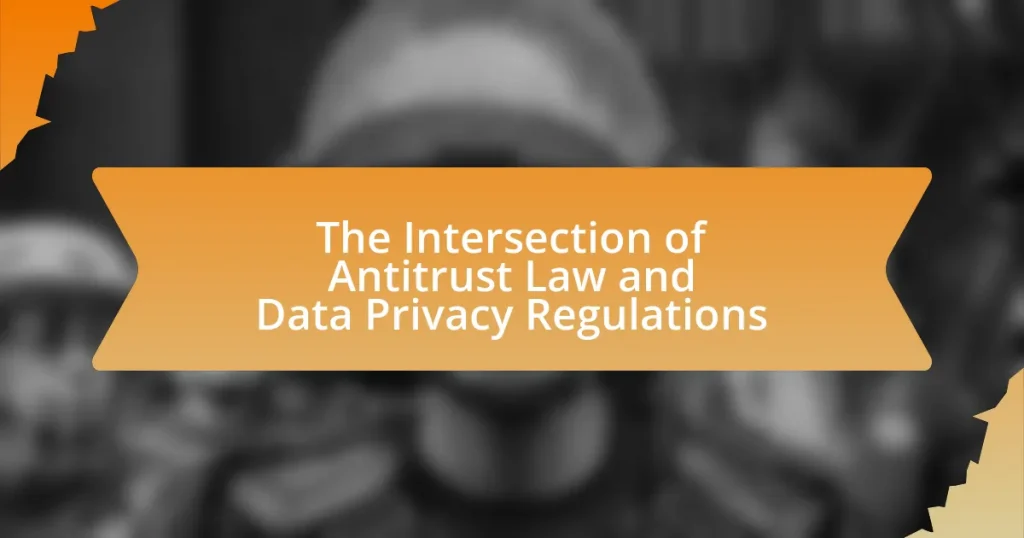The article focuses on legislative responses to mergers and acquisitions in the pharmaceutical industry, emphasizing the role of antitrust laws and regulatory scrutiny in preventing anti-competitive practices. It outlines key legislative frameworks such as the Clayton Act, the Hart-Scott-Rodino Act, and the Federal Trade Commission Act, which govern merger assessments in the U.S. and the European Union. The article discusses the importance of these regulations in maintaining market competition, protecting consumer interests, and addressing challenges posed by lobbying and economic conditions. Additionally, it explores how international regulations influence domestic mergers and highlights future trends in legislative responses, including the impact of emerging technologies and data privacy concerns.

What are Legislative Responses to Mergers and Acquisitions in the Pharmaceutical Industry?
Legislative responses to mergers and acquisitions in the pharmaceutical industry primarily involve antitrust laws and regulatory scrutiny aimed at preventing anti-competitive practices. In the United States, the Federal Trade Commission (FTC) and the Department of Justice (DOJ) assess proposed mergers to ensure they do not substantially lessen competition or create a monopoly, as outlined in the Clayton Act of 1914. For instance, the FTC blocked the merger between AbbVie and Allergan in 2020, citing concerns over reduced competition in the market for certain drugs. Similarly, the European Commission conducts thorough investigations under EU competition law, which can lead to prohibitions or demands for divestitures in cases where mergers threaten market competition. These legislative frameworks are designed to maintain fair competition and protect consumer interests in the pharmaceutical sector.
Why are legislative responses important in the context of mergers and acquisitions?
Legislative responses are important in the context of mergers and acquisitions because they ensure regulatory oversight and protect market competition. These responses help prevent monopolistic practices that can arise from mergers, which may lead to higher prices and reduced innovation in the pharmaceutical industry. For instance, the Federal Trade Commission (FTC) in the United States actively reviews proposed mergers to assess their impact on competition, as seen in the scrutiny of the 2015 merger between Pfizer and Allergan, which was ultimately abandoned due to regulatory concerns. Such legislative measures are crucial for maintaining a fair marketplace and safeguarding consumer interests.
What role do regulations play in shaping pharmaceutical mergers and acquisitions?
Regulations play a critical role in shaping pharmaceutical mergers and acquisitions by establishing legal frameworks that govern antitrust considerations, market competition, and consumer protection. These regulations, enforced by agencies such as the Federal Trade Commission (FTC) and the European Commission, assess whether proposed mergers could substantially lessen competition or create monopolistic practices. For instance, in 2016, the FTC blocked the merger between two pharmaceutical companies, asserting that it would lead to higher drug prices and reduced innovation. This demonstrates how regulatory scrutiny can prevent mergers that may harm market dynamics and consumer welfare, thereby influencing the strategic decisions of companies in the pharmaceutical sector.
How do legislative responses impact competition in the pharmaceutical market?
Legislative responses significantly impact competition in the pharmaceutical market by regulating mergers and acquisitions to prevent monopolistic practices. For instance, antitrust laws, such as the Clayton Act, empower regulatory bodies like the Federal Trade Commission to scrutinize proposed mergers that could reduce competition, thereby ensuring a diverse market landscape. Historical examples include the blocked merger between Pfizer and Allergan in 2016, which was halted due to concerns over reduced competition and higher drug prices. Such legislative actions maintain competitive dynamics, fostering innovation and keeping prices in check for consumers.
What are the key legislative frameworks governing pharmaceutical mergers and acquisitions?
The key legislative frameworks governing pharmaceutical mergers and acquisitions include the Hart-Scott-Rodino Antitrust Improvements Act, the Clayton Act, and the Federal Trade Commission Act. The Hart-Scott-Rodino Act requires companies to file pre-merger notifications with the Federal Trade Commission and the Department of Justice, allowing these agencies to review potential anti-competitive effects before the merger is completed. The Clayton Act prohibits mergers and acquisitions that may substantially lessen competition or tend to create a monopoly, while the Federal Trade Commission Act empowers the FTC to prevent unfair methods of competition and deceptive acts in commerce. These frameworks collectively ensure that mergers and acquisitions in the pharmaceutical sector are scrutinized for their impact on market competition and consumer welfare.
What specific laws and regulations apply to mergers and acquisitions in the pharmaceutical sector?
The specific laws and regulations that apply to mergers and acquisitions in the pharmaceutical sector include the Hart-Scott-Rodino Antitrust Improvements Act, the Federal Trade Commission Act, and the Clayton Act. The Hart-Scott-Rodino Act requires companies to file pre-merger notifications with the Federal Trade Commission and the Department of Justice if the transaction meets certain thresholds, allowing for antitrust review. The Federal Trade Commission Act prohibits unfair methods of competition and deceptive acts, while the Clayton Act addresses anti-competitive practices and mergers that may substantially lessen competition or tend to create a monopoly. These laws are designed to ensure that mergers and acquisitions do not harm competition in the pharmaceutical market, which is critical for maintaining innovation and access to medications.
How do international regulations influence domestic pharmaceutical mergers?
International regulations significantly influence domestic pharmaceutical mergers by establishing compliance standards that companies must adhere to during the merger process. These regulations, such as antitrust laws and trade agreements, dictate the conditions under which mergers can occur, often requiring thorough reviews to assess their impact on competition and market dynamics. For instance, the European Union’s Merger Regulation mandates that companies notify the European Commission of mergers that meet specific thresholds, allowing for scrutiny that can lead to prohibitions or conditions on the merger. This regulatory framework ensures that domestic mergers align with international standards, thereby affecting strategic decisions made by pharmaceutical companies regarding consolidation efforts.
What challenges do legislators face in regulating pharmaceutical mergers and acquisitions?
Legislators face significant challenges in regulating pharmaceutical mergers and acquisitions due to the complexity of the industry and the rapid pace of innovation. The pharmaceutical sector is characterized by intricate scientific and economic factors, making it difficult for lawmakers to fully understand the implications of mergers. Additionally, the lobbying power of large pharmaceutical companies can influence regulatory outcomes, as these companies often have substantial resources to advocate for their interests. Furthermore, legislators must balance the need for competition with the potential benefits of consolidation, such as increased investment in research and development. The lack of comprehensive data on the long-term effects of mergers on drug prices and access also complicates the regulatory process, as evidenced by studies indicating that mergers can lead to higher prices for consumers.
What are the potential conflicts of interest in legislative responses?
Potential conflicts of interest in legislative responses to mergers and acquisitions in the pharmaceutical industry include the influence of lobbyists, financial ties between legislators and pharmaceutical companies, and the prioritization of corporate interests over public health. Lobbyists often exert pressure on lawmakers to shape legislation favorably for the industry, which can lead to regulations that benefit companies rather than consumers. Additionally, legislators may have personal investments in pharmaceutical firms, creating a direct financial incentive to support legislation that favors those companies. Historical examples, such as the 2003 Medicare Prescription Drug, Improvement, and Modernization Act, illustrate how corporate interests can overshadow public welfare in legislative decisions.
How do lobbying efforts affect legislative outcomes in the pharmaceutical industry?
Lobbying efforts significantly influence legislative outcomes in the pharmaceutical industry by shaping policy decisions and regulatory frameworks. Pharmaceutical companies invest heavily in lobbying to advocate for favorable legislation, often resulting in laws that support their business interests, such as patent protections and pricing regulations. For instance, in 2020, the pharmaceutical industry spent over $300 million on lobbying efforts in the United States, which contributed to the passage of legislation that favored drug pricing strategies. This financial influence allows the industry to effectively communicate its priorities to lawmakers, thereby impacting the legislative process and outcomes related to mergers and acquisitions.
How do recent trends in mergers and acquisitions affect legislative responses?
Recent trends in mergers and acquisitions in the pharmaceutical industry prompt legislative responses aimed at enhancing regulatory scrutiny and consumer protection. As consolidation increases, lawmakers are concerned about potential monopolistic practices and the impact on drug prices and innovation. For instance, the Federal Trade Commission has intensified its review processes for proposed mergers, reflecting a legislative shift towards stricter antitrust enforcement. This response is evidenced by the introduction of new guidelines that require more comprehensive assessments of market competition and consumer welfare in merger evaluations.
What are the implications of legislative responses for stakeholders in the pharmaceutical industry?
Legislative responses to mergers and acquisitions in the pharmaceutical industry significantly impact stakeholders by altering market dynamics, regulatory compliance, and competitive landscapes. For instance, increased scrutiny from regulatory bodies can lead to prolonged approval processes, affecting timelines and costs for pharmaceutical companies. Additionally, legislation aimed at promoting competition may limit the market power of larger firms, thereby influencing pricing strategies and access to medications for consumers. Furthermore, stakeholders such as investors may experience fluctuations in stock prices due to uncertainties surrounding regulatory approvals or potential legal challenges. These implications underscore the critical role of legislative frameworks in shaping the operational environment for pharmaceutical stakeholders.

How do different countries approach legislative responses to pharmaceutical mergers and acquisitions?
Different countries approach legislative responses to pharmaceutical mergers and acquisitions through varying regulatory frameworks and enforcement mechanisms. For instance, the United States employs the Hart-Scott-Rodino Act, which mandates pre-merger notification to the Federal Trade Commission and the Department of Justice, allowing for antitrust reviews. In contrast, the European Union utilizes the Merger Regulation, which assesses mergers based on their impact on competition within the internal market, often leading to more stringent scrutiny compared to the U.S. approach. Additionally, countries like Canada have their own Competition Act, which similarly requires notification and review of mergers that may substantially lessen competition. These legislative frameworks reflect each country’s priorities in balancing market competition with the need for innovation and access to pharmaceuticals.
What are the differences in legislative frameworks across major markets?
Legislative frameworks across major markets differ significantly in their approach to mergers and acquisitions in the pharmaceutical industry. In the United States, the Federal Trade Commission (FTC) and the Department of Justice (DOJ) assess mergers based on potential anti-competitive effects, guided by the Clayton Act and the Sherman Act, which emphasize consumer welfare and market competition. In contrast, the European Union employs a more precautionary principle under the EU Merger Regulation, where the European Commission evaluates mergers not only for competition concerns but also for their impact on innovation and market structure, often leading to more stringent scrutiny and conditions for approval.
Additionally, in countries like Japan, the Japan Fair Trade Commission (JFTC) follows a similar anti-monopoly framework but incorporates unique cultural and economic considerations, which can result in different thresholds for intervention compared to Western markets. In emerging markets such as India, the Competition Commission of India (CCI) focuses on preventing practices that may adversely affect competition, but its regulatory environment is still evolving, leading to inconsistencies in enforcement and interpretation of merger guidelines.
These differences highlight how varying legislative frameworks reflect distinct economic priorities and regulatory philosophies across major markets, influencing the strategic decisions of pharmaceutical companies during mergers and acquisitions.
How does the U.S. approach differ from the EU in regulating pharmaceutical mergers?
The U.S. approach to regulating pharmaceutical mergers primarily focuses on consumer welfare and market competition, while the EU emphasizes broader public interest and potential impacts on innovation. In the U.S., the Federal Trade Commission (FTC) and the Department of Justice (DOJ) assess mergers based on their effects on prices and consumer choice, often allowing mergers that do not significantly harm competition. Conversely, the EU’s European Commission evaluates mergers not only on competition but also on their implications for public health and access to medicines, often leading to stricter scrutiny and conditions for approval. For instance, in 2019, the EU blocked the merger between Illumina and Grail, citing concerns over innovation and access to cancer detection technologies, while similar mergers in the U.S. may have been approved if they did not substantially lessen competition.
What lessons can be learned from countries with stringent merger regulations?
Countries with stringent merger regulations demonstrate that effective oversight can prevent monopolistic practices and promote competition. For instance, the European Union’s rigorous antitrust laws have successfully blocked mergers that would significantly reduce competition, such as the proposed merger between Siemens and Alstom in 2019, which was rejected to maintain a competitive rail market. Additionally, these regulations often lead to more thorough assessments of potential impacts on innovation and consumer welfare, as seen in the U.S. Federal Trade Commission’s scrutiny of pharmaceutical mergers, which aims to protect drug affordability and access. Overall, the lessons indicate that stringent regulations can safeguard market integrity and consumer interests while fostering a competitive environment.
How do cultural and economic factors influence legislative responses?
Cultural and economic factors significantly influence legislative responses by shaping public perception and policy priorities. Cultural values, such as attitudes toward healthcare and corporate ethics, can drive lawmakers to prioritize regulations that protect public interests, as seen in countries with strong public health systems advocating for stringent merger reviews. Economic factors, including market competition and financial stability, compel legislators to consider the potential impacts of mergers on drug prices and innovation, leading to interventions aimed at maintaining market balance. For instance, the Federal Trade Commission in the United States often assesses mergers in the pharmaceutical sector based on their potential to reduce competition and harm consumers, reflecting both economic concerns and cultural expectations for accessible healthcare.
What role does public opinion play in shaping merger regulations?
Public opinion significantly influences the formulation of merger regulations, particularly in the pharmaceutical industry. Regulatory bodies often consider public sentiment to gauge potential backlash against mergers that may lead to higher drug prices or reduced competition. For instance, public outcry over the merger between Pfizer and Allergan in 2016 highlighted concerns regarding market monopolization and drug affordability, prompting regulatory scrutiny. This demonstrates that when public opinion is vocal and critical, it can lead to more stringent regulatory assessments and potential rejections of proposed mergers.
How do economic conditions affect the enforcement of merger laws?
Economic conditions significantly influence the enforcement of merger laws by altering regulatory priorities and resources. During economic downturns, regulators may prioritize maintaining market stability over strict enforcement, leading to more lenient scrutiny of mergers. For instance, in the 2008 financial crisis, the U.S. Federal Trade Commission adopted a more flexible approach to merger reviews, allowing certain consolidations to proceed to support economic recovery. Conversely, in robust economic periods, regulators often intensify scrutiny to prevent anti-competitive practices, as seen in the increased enforcement actions in the pharmaceutical sector during the late 1990s when the industry experienced rapid consolidation. This relationship between economic conditions and merger law enforcement underscores the adaptive nature of regulatory frameworks in response to market dynamics.

What are the future trends in legislative responses to mergers and acquisitions in the pharmaceutical industry?
Future trends in legislative responses to mergers and acquisitions in the pharmaceutical industry include increased scrutiny and regulation aimed at preventing anti-competitive practices and ensuring drug affordability. Regulatory bodies, such as the Federal Trade Commission in the United States, are likely to adopt more stringent guidelines that assess the impact of mergers on market competition and consumer access to medications. For instance, recent legislative proposals have emphasized the need for transparency in pricing and the potential effects of consolidation on innovation and drug prices. Additionally, there is a growing trend towards international cooperation among regulatory agencies to address cross-border mergers, reflecting a global approach to pharmaceutical regulation. These trends are driven by public demand for lower drug prices and greater accountability from pharmaceutical companies.
How might emerging technologies impact legislative approaches?
Emerging technologies can significantly impact legislative approaches by enabling more efficient data analysis and enhancing transparency in regulatory processes. For instance, the use of artificial intelligence and machine learning can help lawmakers analyze large volumes of data related to mergers and acquisitions, allowing for more informed decision-making. Additionally, blockchain technology can improve transparency in transactions, making it easier to track compliance with regulations. These advancements can lead to more adaptive and responsive legislative frameworks that better address the complexities of the pharmaceutical industry, as evidenced by the increasing integration of technology in regulatory practices observed in recent years.
What is the potential for digital health innovations to change merger regulations?
Digital health innovations have the potential to significantly change merger regulations by introducing new metrics for assessing competition and consumer welfare. These innovations, such as telemedicine and health data analytics, can alter market dynamics, making traditional regulatory frameworks inadequate. For instance, the rise of digital health platforms can lead to increased access and lower costs, which may necessitate a reevaluation of how mergers are analyzed in terms of their impact on consumer choice and market concentration. Regulatory bodies may need to adapt their criteria to account for the unique characteristics of digital health, such as data interoperability and the role of technology in enhancing patient outcomes, thereby ensuring that merger assessments reflect the evolving landscape of healthcare delivery.
How could data privacy concerns shape future legislative responses?
Data privacy concerns could significantly shape future legislative responses by prompting stricter regulations on data handling and sharing practices within the pharmaceutical industry. As public awareness of data breaches and misuse increases, legislators may introduce laws that enforce transparency in how pharmaceutical companies collect, store, and utilize personal data. For instance, the implementation of the General Data Protection Regulation (GDPR) in the European Union has already set a precedent for stringent data protection measures, influencing similar legislative efforts globally. Additionally, ongoing discussions around the ethical implications of data use in drug development and patient care may lead to the establishment of frameworks that prioritize consumer rights and data security, ensuring that companies are held accountable for their data practices.
What best practices can be adopted for effective legislative responses?
Effective legislative responses can be achieved by implementing comprehensive regulatory frameworks that ensure transparency, accountability, and stakeholder engagement. These frameworks should include rigorous antitrust assessments to prevent monopolistic practices, as evidenced by the Federal Trade Commission’s guidelines which emphasize the importance of evaluating market competition. Additionally, fostering collaboration between regulatory bodies and industry stakeholders can enhance the legislative process, as seen in successful initiatives like the European Medicines Agency’s consultations during drug approvals. Regular reviews and updates of legislation based on market dynamics and technological advancements are also crucial, supported by data from the Organisation for Economic Co-operation and Development, which highlights the need for adaptive regulatory approaches in rapidly evolving sectors like pharmaceuticals.
How can legislators ensure a balance between innovation and regulation?
Legislators can ensure a balance between innovation and regulation by implementing adaptive regulatory frameworks that promote flexibility while safeguarding public interests. These frameworks can include mechanisms for real-time feedback from stakeholders, such as industry experts and consumer advocates, which allows for timely adjustments to regulations as new technologies and practices emerge. For instance, the FDA’s Breakthrough Devices Program exemplifies a regulatory approach that accelerates the approval of innovative medical devices while maintaining safety standards, demonstrating that effective regulation can coexist with innovation.
What strategies can be implemented to enhance stakeholder engagement in the legislative process?
To enhance stakeholder engagement in the legislative process, strategies such as establishing regular communication channels, facilitating public consultations, and utilizing technology for outreach can be implemented. Regular communication channels, including newsletters and updates, keep stakeholders informed about legislative developments, fostering transparency. Public consultations allow stakeholders to voice their opinions and contribute to the legislative discourse, which can lead to more informed decision-making. Utilizing technology, such as social media platforms and online forums, enables broader participation and engagement, particularly among younger demographics. These strategies have been shown to increase stakeholder involvement and improve the quality of legislative outcomes, as evidenced by successful legislative initiatives that incorporated stakeholder feedback, leading to more effective policies in various sectors, including the pharmaceutical industry.



